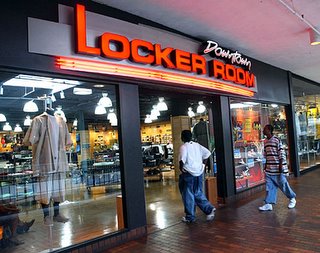 Baltimore's oldest shopping mall might get two new anchors and possibly a Target store, but owner General Growth Properties and others involved aren't talking before a presentation to the city's urban design panel
Baltimore's oldest shopping mall might get two new anchors and possibly a Target store, but owner General Growth Properties and others involved aren't talking before a presentation to the city's urban design panelAndrea K. Walker
Baltimore Sun reporter
Mondawmin Mall, Baltimore's oldest shopping mall, has been largely neglected over the years, residents and merchants say.
Now, it has plans to change that.
Chicago-based General Growth Properties Inc. tomorrow is to present to the city's Urban Design and Architecture Review Panel plans to add two new anchors and a big-box retailer to the mall property, according to a mall spokesman. It also plans to develop two lots on the site that could possibly accommodate a family restaurant.
Talk among the city's development circles is that Target Corp. is in discussions for space. That would be a striking turn for the Minneapolis-based retailer that's become the nation's second-largest by locating largely along suburban strips or in high-end space downtown. Recently, the company, like other big-box retailers, has been looking at more urban locations as fewer suburban spaces remain available.
Target wouldn't confirm yesterday that it is looking at the site. General Growth didn't return calls about the mall.
"While we're generally interested in the area, it's too soon to say we're definitely coming and it would be premature to discuss the specifics," said Joshua Thomas, a Target spokesman.
David Ward, president of H&R Retail in Timonium, the brokerage that works with Target in Baltimore, said the retailer doesn't typically discuss where it is locating until at least building permits have been issued. "I'm not at liberty to discuss any of Target's new store plans," he said.
Retail experts and community groups say redevelopment is long overdue for the mall, which opened in 1956 as Baltimore's first two-level enclosed shopping center. It since has become a hodgepodge of sneaker stores and small urban wear shops.
"It does well now and that's just based on pure need," said Thomas H. Maddux, president of KLNB Retail, a commercial real estate company in Towson. "I think if it's redeveloped properly, there's no way it doesn't work."
Mondawmin is one of the city's few shopping sites with a large parking lot. Parking is one of the issues that have made retailers reluctant to move to city locations. Mondawmin is also convenient to many parts of the city and Baltimore County and it is easily accessible to Interstate 83.
"There's a lot of traffic there," said Mark Millman of Millman Search Group, an executive search firm in Owings Mills. "It's close to downtown and other parts of Baltimore. It's very active and vibrant. There is a large volume of people that live in the general area."
City planners want to promote Mondawmin as an example of transit-oriented development, a planning concept that concentrates new construction near major transit stops.
Mondawmin is the site of a key bus hub and a Metro subway stop. It is also beside a Maryland Motor Vehicle Administration office, which draws motorists from various parts of the city and beyond.
Plans call for creating pathways that lead from the mall to the nearby Maryland Zoo in Baltimore, Coppin State University and Druid Hill Park, city planners said.
"We're trying to get more density in the area and more people using the transit station," said Andrea Limauro, a city planner for West Baltimore, which includes Mondawmin.
"Hopefully, that will bring more of a critical mass in the area that shops around and walks around. We are excited about this. Because the more people in the streets, the more appealing the neighborhood will be for future development," Limauro said.
The mall was anchored by a Sears, Roebuck store and catered to the neighborhood's mostly Jewish residents when it opened a half-century ago. When blacks began moving to the area, national retailers began to withdraw, fearing there wouldn't be enough support for their stores, according to previous articles in The Sun. Sears pulled out in 1973. Reports of crime, including shootings and muggings in the parking lot, worsened the mall's reputation.
The Rouse Co., which developed the mall, eventually took over its ownership. By the mid-1980s, the mall had new tenants and was successful again.
But by the 1990s, the mall again struggled to attract new tenants. It never attracted another anchor to replace Sears.
In 1999, Rouse presented plans to the design advisory panel that included space for a supermarket, a big-box retailer and a 10,000- square-foot restaurant. Home Depot and Metro Food Markets were said to have expressed interest in the site at the time. But the development company never proceeded with the plans. The mall was sold along with the rest of Rouse's portfolio, which General Growth acquired for $12.6 billion, including cash and assumed debt, in 2004.
The mall's location in a distressed neighborhood may seem like an unlikely focus for Target and other national retailers. But having flooded some suburban markets, retailers have increasingly eyed urban neighborhoods for growth prospects. They've experimented with new designs, such as multilevel stores with parking garages that work better in densely populated areas.
"I think that is part of a larger story of retailers saturating the more urban markets," KLNB's Maddux said. "Once they've finished with all the outer suburban markets, the only place left to go is the city. Retailers are being much more creative with multilevel stores and structured parking."
General Growth held meetings with area community groups last month to discuss proposed changes to the mall. Although, they didn't reveal specific tenants, the groups seemed pleased with preliminary plans.
"It's not only going to be hip-hop anymore," said Sandra Almond-Cooper, president of the Mondawmin Neighborhood Improvement Association and the Greater Mondawmin Coordinating Council. "We can bring it back to what serves the whole community."
No comments:
Post a Comment